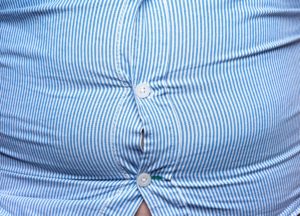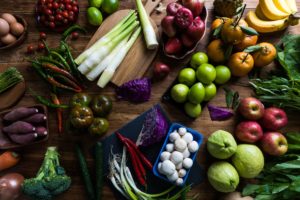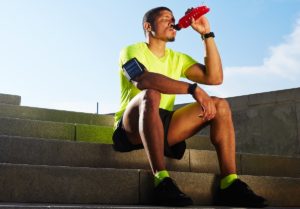Supplements/Ergogenic Aids
Join the Culinary Movement
The best method for helping someone make healthier nutrition choices goes beyond providing nutrition education and reciting key points from the Dietary Guidelines for Americans. It includes helping people develop the skills needed to translate information into real life—that is, living the DGA.
Metabolic Health Versus Weight
Despite more than a decade of intensive efforts to reverse the adult and childhood obesity crises, obesity remains widespread. Generally, the first treatment recommendation is to lose weight, but losing large amounts of weight and keeping it off is difficult, and possibly not even the best reflection of health improvements. After all, the number on a scale is just one measure of health.
Stay Tuned on Nutrition Label Updates
The timing of nutrition label updates to include added sugars, among other changes, remains in flux as government officials offer differing timelines. As of press time, the official word is that you can expect to see the new labels on all products in January 2020, according to the Center for Science in the Public Interest. Despite the delay, many food companies are still planning on rolling out updated labels by the original deadline of July 2018.
Health Coaches and Fit Pros Can Broaden Reach in Clinical Practice
Authors of a recent viewpoint published in the prestigious Journal of the American Medical Association issued a call for clinicians to incorporate more nutrition counseling into their patient interactions to better help people improve health outcomes. The authors noted that our changing healthcare system offers clinicians more opportunities to engage patients in nutrition counseling, though few do.
Can an AI App Help Us Eat Better? FitGenie Wants to Try
Because self-monitoring of dietary intake is critical to achieving weight and nutrition goals, demand is high for easy-to-use apps that make food tracking easier, help users interpret the results, and use data to set goals and develop meal plans. FitGenie is an innovative app that uses artificial intelligence to give people their own “nutritionist” that tailors meal plans and recommendations based on individual factors, according to the popular technology blog TechCrunch. And more apps are likely to follow.
Should I Sprout Beans or Seeds Before Eating Them?
Question: Is there a nutritional benefit to sprouting beans or other seeds?
Answer: While I don’t want to discourage you from eating nutritious beans and seeds that haven’t been sprouted, sprouting or germinating seeds does change their nutritional profile and make them more digestible. All kinds of seeds make delicious sprouts.
These include
PURE Multicountry Nutrition Study Supports What We Already Know—Despite Headlines to the Contrary
Just what the wellness community needed—yet another study questioning what we thought we knew about nutrition and health.
When results of the massive, multicontinent “PURE” (Prospective Urban Rural Epidemiology) nutrition study were published, headlines blared:
Take A Diet Break, Lose Weight
When you first start trying to lose weight, the math is straightforward: To lose 1 pound, create a 3,500-calorie deficit by eating less and moving more. But as the weight comes off, the body’s metabolism slows as it tries to maintain a “set point” weight, and the math stops working. People need a greater caloric deficit to keep losing weight. And for most people, the weight creeps back up over time.
One Size Fits One
Ozzy Osbourne was curious and decided to have his genome sequenced.
“Given the swimming pools of booze I’ve guzzled over the years—not to mention all of the cocaine, morphine, sleeping pills, cough syrup, LSD, Rohypnol . . . you name it—there’s really no plausible medical reason why I should still be alive,” he said in the Sunday Times of London in 2010.
“Maybe my DNA could say why.”
Eating Right: What the Science Says
Technology makes so much nutrition information available at the touch of a button that people get muddled about what, when and how much to eat. Case in point: A Google search of “intermittent fasting” yields a mix of criticism and rave reviews. Numerous varieties of intermittent fasting also pop up, adding to the confusion. How do you give your clients practical, evidence-based suggestions amid all these mixed signals? Below, experts weigh in with scientifically grounded advice on some
of your clients’ most pressing nutrition questions.
Healthy Holiday Recipes
Enjoy the season in a healthy way by cleaning up your diet and choosing some of these healthy holiday recipes.
Nutrition Ideas for Your Club or Studio
From small studios to nationwide club chains, fitness companies are finding ways to help clients get better at navigating their nutritional challenges. They’re doing things like
building smoothie bars,
convening healthy supper clubs with candlelight dinners,
bringing in chefs to provide cooking demonstrations, and
offering seminars with registered dietitians.
Lessons From 40 years of Dietary Guidelines for Americans
The history of the Dietary Guidelines for Americans (DGA) provides a fascinating glimpse into what has stayed the same (eat plenty of fruits and veggies) and what has changed (dietary cholesterol isn’t so evil after all) in the past four decades.
Issued by the U.S. Department of Agriculture (USDA) and the Department of Health and Human Services (HHS), the DGA have amassed immense influence since the first ones were published in 1980. All U.S.
Spread The Love
Almond butter was the first to challenge the decades-long dominance of creamy and crunchy peanut butter. Now, seed butters represent a hot new trend in spreads, each offering a unique flavor and nutritional profile. This trio of no-nut spreads is worthy of pantry space: Sesame Seed Butter Often labeled as tahini, this spread of ground sesame seeds has a rich, smoky flavor and velvety texture. As a good source of mono- and polyunsaturated fats, it can help keep your heart strong.
Most Coffee Drinkers Can Sip Their Brew Worry-Free
Here is some buzz-worthy news: Scientists seem to have pinpointed how many cups of coffee we can safely drink each day. A large 2017 review of studies published in Food and Chemical Toxicology determined that consuming up to 400 milligrams of caffeine per day—which would include sources like tea and chocolate, too—has no detrimental impact on health measures such as bone strength or cardiovascular well-being. That amount represents about 4 cups of coffee.
Ask the RD: Is kefir like yogurt?
Question: Is kefir like yogurt? Does it have the same health benefits?
Answer: Kefir is a tart, fermented-milk product similar to yogurt. It is thought to have originated in the Caucasus Mountains, where it is traditionally made from cow, sheep or goat milk. Kefir is sometimes slightly carbonated and may contain small amounts of alcohol.
Liquid Sugar Keeps on Flowing
As the dangers of drinking too much soda (diabetes, obesity, etc.) become increasingly known to the public, sales continue to drop, but it seems we are simply replacing one nutrition villain with another. According to the marketing firm Packaged Facts, sales of sports and energy drinks are rocketing upward—hitting an estimated $25 billion in 2016 with an annual growth rate of 7%.
Do the Well-Heeled Eat Less Fast Food Than the Poor?
Because fast food is thought to be relatively inexpensive, there’s an assumption that people with lower incomes have a bigger soft spot for it than those in higher-grossing socioeconomic groups. Now, a 2017 study in the journal Economics & Human Biology is challenging this assertion. In the paper, which drew from a large sample of Americans, researchers discovered that the guilty pleasure of biting into a Big Mac is shared across the income spectrum, from rich to poor.
Protein Guidelines for Elderly and Endurance Athletes Need a Boost
Muscle men aren’t the only ones needing to load up on more protein. Recent evidence suggests that the current Recommended Dietary Allowance (RDA) for protein, which is 0.8 gram per kilogram of body weight per day for healthy adults over age 19, is too low for elderly people and those who engage in high volumes of aerobic activity. A May 2017 Frontiers in Nutrition paper makes a strong argument that older adults can have lower rates of muscle and function loss with protein intakes of 1.2–1.5 g/kg BW/day.


















